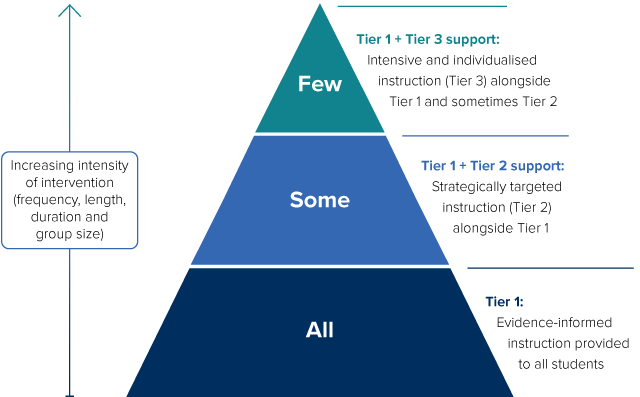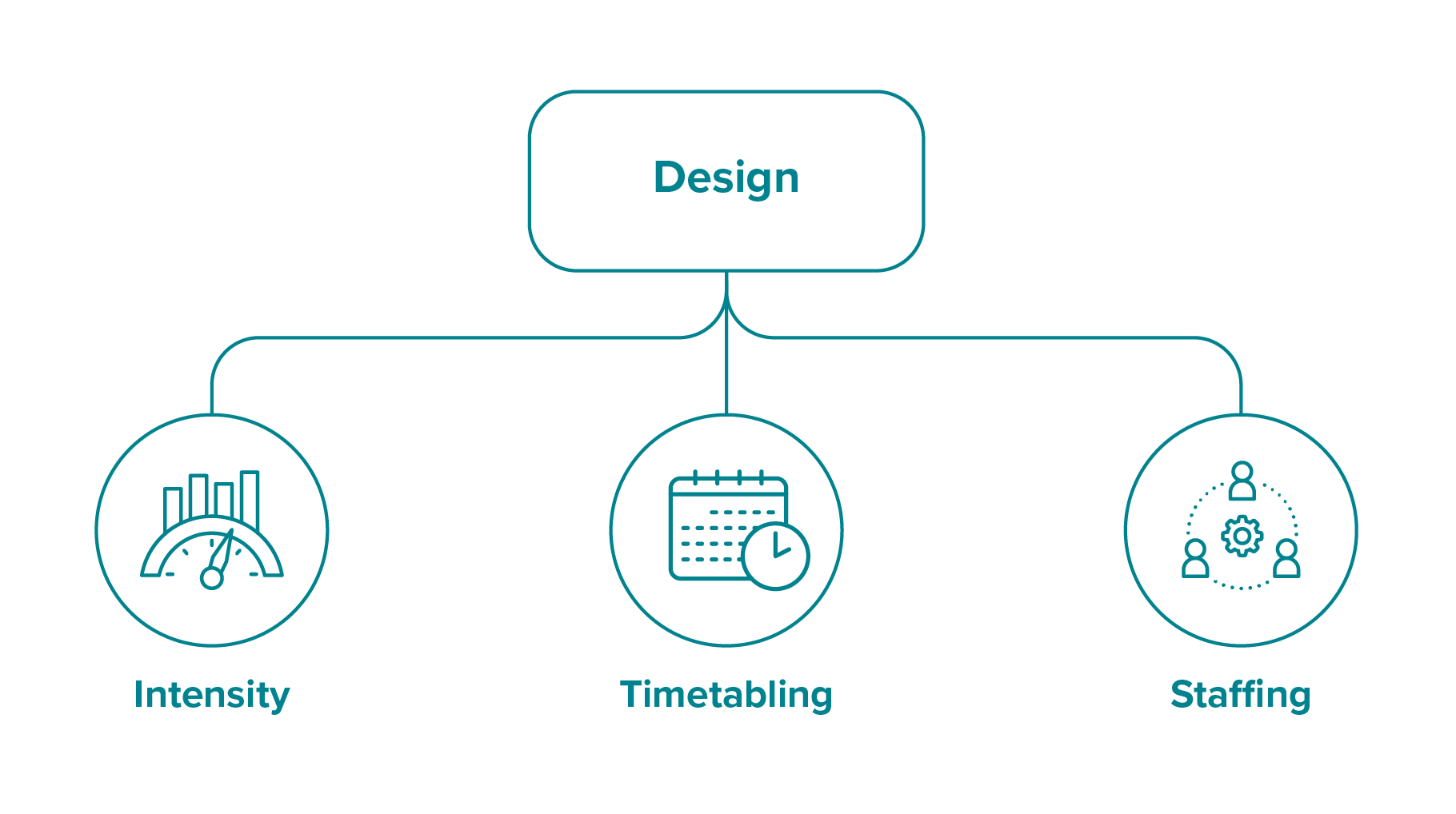Currently, 1 in 5 students across Australia starts secondary school at or below the minimum standards for literacy and numeracy. Students struggling with these foundational skills often become disengaged and fall further behind their peers, making it difficult for them to catch up. Identifying these students early and providing them with targeted intervention using instruction backed by evidence is key in helping them to acquire the skills they need to set them up for future success, reducing the risk of widening gaps in achievement.
The Australian Education Research Organisation (AERO) recommends the use of a multi-tiered system of supports (MTSS) to better assist Years 7 to 9 students struggling with foundational literacy and numeracy skills. MTSS has been widely recognised as an effective approach for supporting these students by allowing early identification, intervention and the tracking of progress. Using a data-driven approach that provides varying levels of instructional support based on student needs, MTSS allows for universal screening of all students, followed by increasing tiers of intervention, as needed [see Figure 1].
- Tier 1 delivers high-quality classroom instruction for the entire class.
- Tier 2 provides a higher intensity of high-quality instruction for students not yet mastering skills required to fully engage with their year-level curriculum.
- Tier 3 offers intensive support, often one-on-one, for those who require the greatest amount of support.
Student progress is then continuously monitored, and interventions are adjusted accordingly, ensuring timely and appropriate support.

New suite of MTSS resources
AERO has developed a comprehensive suite of resources aimed at supporting school leaders and teachers in delivering or enhancing MTSS, including:
- evidence explainers covering the research behind important topics and concepts related to supporting students struggling with foundational skills
- practice guides explaining effective evidence-based practices when delivering MTSS, and helping schools to identify next steps in effectively delivering MTSS
- practice resources providing practical applications for implementing and building proficiency in delivering MTSS in schools
- video snapshots of practice showing 7 schools across Australia that have implemented MTSS, along with themed video snapshots showing how best practice can be delivered across multiple school contexts
- a research report outlining practical design considerations for a tiered interventions approach including setting up and resourcing MTSS (staffing, timetabling and intensity of intervention).
Depending on a leader’s or teacher’s familiarity with an MTSS framework, the suite of resources can be curated – whether it’s to help decide if MTSS is suitable for their school’s context or if they are ready to implement an MTSS framework and want guidance on next steps. The Multi-tiered System of Supports: User Guide provides an ideal starting point with comprehensive lists of the most relevant MTSS resources and how best to use them. Some suggested approaches for effectively using these resources are discussed.
An introduction to MTSS
For those curious about MTSS or wishing to deepen their understanding of the framework’s key components, the Introduction to a Multi-tiered System of Supports: Explainer unpacks the key principles of MTSS, outlines the characteristics of MTSS for addressing gaps in literacy and numeracy and details the effective delivery of the 3 tiers of intervention. The content draws on a review of evidence-based approaches for supporting students who are struggling with foundational skills conducted by Kate de Bruin and her team at Monash University, as well as guidance developed in partnership with the Dyslexia-SPELD Foundation (DSF).
In addition to the Explainer, those new to MTSS can get a broader understanding of the types of assessments available in MTSS, as well as guidance on supporting the wellbeing and engagement of students receiving intervention. AERO’s suite of short MTSS videos capturing 7 schools across Australia helps to demonstrate how this framework can be applied in a range of contexts. A complete list of these introductory resources can be found in the section ‘To introduce MTSS’ in the User Guide.
Leading and operationalising MTSS
School and educational leaders who are already familiar with MTSS who may be ready to implement a framework in their schools should look at our research report on Designing an Intervention Approach: Making Staffing and Timetabling Decisions.
This will help to make practical school decisions concerning important topics such as:
- timetabling: how schools should make time for tiered interventions in their regular timetable.
- staffing: how school staff can support the delivery of intervention instruction.
- intensity: how ‘intensely’ students experience interventions including group size, frequency, length and intervention duration.

While intensity and timetabling are essential to the design approach, research shows that understanding the value of a dedicated team of educators and teachers with a committed leadership group is what ultimately ensures the program’s long-term success and overall effectiveness.
Whole-school approach
MTSS delivery must be a whole-school approach with buy-in from all staff, whether or not they are leading or delivering interventions. Those teaching subjects outside of English/literacy and mathematics/numeracy especially need to recognise how literacy and numeracy difficulties can affect student outcomes – across the curriculum, across different subjects, and in their future academic and occupational success. This shared understanding supports staff in negotiating timetabling arrangements – for instance, where students may need to be withdrawn from elective subjects to participate in intervention.
Cross-tier collaboration between staff delivering Tier 1 instruction and those delivering Tier 2 and 3 interventions is also necessary. This helps to support careful screening and flexible movement of students across tiers based on data and teacher judgement, as well as strengthening connections between in-class and out-of-class learning coherence and effectiveness. Regular case management meetings between literacy and numeracy specialists, leadership, and teaching staff across all tiers will help to support and sustain this whole-school approach.
‘There’s a massive group of us that all work really closely together to make our tiered intervention happen. My role as the English coordinator looks at the systems and structures, the staffing, timetabling. Then we have our literacy lead teacher, who plans the actual curriculum and lesson planning. Our senior speech pathologist and her work really closely on that together. Our inclusive education assistant principal helps in identifying those students and making sure that they’re getting what they need. Then we obviously have a lot of support from our deputy and our principal in running programs like this.’
– Beth Pontifex, English Coordinator, Parafield Gardens High School, SA
Leadership to champion MTSS
For MTSS to be successful, school leaders must prioritise and champion its use and implementation. The most effective cases of successful implementation have been when leaders have:
- set a vision for effective MTSS delivery
- fostered an environment that encourages communication and collaboration
- been the ‘gatekeepers’ of student and staff time, physical space and budget
- continually encouraged support from staff, students and the school community (including parents or caregivers).
Building an effective MTSS team
Schools implementing an MTSS framework will need to set up dedicated teams to provide intervention support. They may vary depending on school context but should comprise of:
- trained teachers – this might include staff with expertise such as special education teachers, and teachers who are primary education-trained (the most effective at providing Tier 2 and 3 instruction to raise outcomes)
- literacy and numeracy specialists
- paraprofessionals such as teaching assistants (TAs)
- specialists such as speech pathologists and psychologists.
Currently, 1 in 5 students across Australia starts secondary school at or below the minimum standards for literacy and numeracy.
Providing dedicated space and time for intervention beyond the general education classroom strengthens learning and teaching processes.
Overall, an interdisciplinary team comprised of trained teachers, literacy and numeracy experts, paraprofessionals, speech pathologists and educational psychologists, helps to maximise a school’s ability to deliver the best results for students.
Professional development and support
Staff across all tiers need to be supported to carry out an MTSS approach, and this involves support in delivering effective teaching practices. AERO’s model of learning and teaching describes what these practices involve. In the early stages of intervention implementation, schools should focus their professional development on developing a tiered model and how they might plan for the appropriate infrastructure to support ongoing implementation. All staff involved in leading and delivering the interventions need to be well-trained in the program they are delivering, to enable staff to deliver interventions with fidelity.
|
|
|
Attention and focusStudents are actively engaged when learning
|
EnablingFoster the conditions of a learning-focused environment
|
Knowledge and memoryLearning is a change in long-term memory
|
PlanningDevelop a teaching and learning plan for the knowledge students will acquire
|
Retention and recallStudents process limited amounts of new information
|
InstructionManage the cognitive load of learning tasks
|
Mastery and applicationStudents develop and demonstrate mastery of their learning
|
Gradual releaseMaximise retention, consolidation, and application of learning
|
‘We are a literacy intervention team. It doesn’t matter who you are, if you are the speech pathologist, the literacy leader, the literacy SSO [school services officer] or the teacher. We’ve all done the same training. It means that there is always someone in our intervention classes who is properly trained. The students feel really supported, that they have a team around them, and staff also feel supported that they have a range of people who they can come to and ask detailed questions.’
– Janette Bandjak, Senior Leader, Literacy, Craigmore High School (SA)
AERO’s reading intervention work would not have been possible without the partnership of the team at the Dyslexia-SPELD Foundation (DSF). AERO is also grateful to its Panel of Educators, Teachers and Leaders (PETL), as well as a range of reading experts and system/sector
leaders who reviewed the work during its development.
Further reading
AERO’s resources are free under Creative Commons and include further information on topics mentioned above such as timetabling and intervention intensity. There are also many resources around using reading intervention in secondary schools, developed in partnership with DSF.
To access the range of resources available and how they should be used, see our MTSS user guide.
About the author
Adam Inder is a Senior Researcher at the Australian Education Research Organisation (AERO), Australia’s independent education evidence body. He has recently led work developing research and guidance for secondary schools to support students lacking foundational literacy and numeracy skills, and is currently developing guidance for more evidence-based practices in schools. Starting out as a maths and science teacher, Adam went on to become a secondary school deputy principal in socioeconomically disadvantaged Perth schools. He has been a School Board Deputy Chair, a TEDx speaker, and is currently a Board Director of The Mathematical Association of Western Australia and an Editorial Board Member at the Australian Council for Educational Leaders. In 2023, Adam was awarded the Australian Council for Educational Leaders’ WA Certificate of Excellence in Educational Leadership Award.
This article is republished from the Learning Difficulties Australia Bulletin with permission.